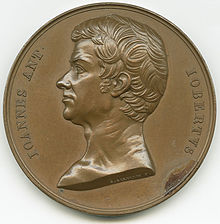Giovanni Antonio Giobert
Giovanni Antonio Giobert, also Jean Antoine Giobert , (born October 28, 1761 in Mongardino near Asti, † September 14, 1834 in Millefiori near Turin ) was an Italian chemist and mineralogist . Among other things, he researched magnetism and galvanism .
Giobert became a member of the Turin Academy of Sciences in 1789. From 1800 he was Professor of Agriculture and from 1802 Professor of Chemistry and Mineralogy at the University of Turin . In the meantime, in 1798, he was involved in the provisional government of Piedmont . Since 1808 he was a corresponding member of the mathematical-physical class of the Bavarian Academy of Sciences .
In 1813, by decree, he was appointed director of the École impériale pour la fabrication de l'indigo in Turin, where the industrial processing of indigo was to be tested.
Giobert developed the Giobertsche or Gioberti tincture named after him , which contains blood liquor salt and hydrochloric acid and was used to make the original inscription on a palimpsest visible. He examined the influence of magnesia on plant growth and found that the presence of the substance in the soil did not have an inhibiting effect.
The mineral giobertite , a form of magnesite (MgCO 3 ), was named after him. In 1864 an institute was named in Asti.
Fonts (selection)
- About some galvanic experiments by Giobert. From a letter to van Mons. In: New general journal of chemistry Frölich, Berlin 1804, volume 3, issue 2, p. 219
- Traité sur le pastel et l'extraction de son indigo. Imprimerie impériale, Paris 1813
- Message for the residents of the Ober-Ems department about the cultivation and use of the woad . Osnabrück 1813, excerpt from Giobert's Traité sur le Pastel et l'extraction de son Indigo
- Del sovescio di Segale. I-IV. Gaetano Balbino, Turin 1819
- Des eaux thermales et acidules de l'Échaillon en Maurienne. Pomba, Turin 1822
- De l'Écorce du Robinier (Robinia pseudo-acacia, L.) et de ses usages dans les arts et l'économie domestique. Huzard née Vallat la Chapelle, [1833]
Individual evidence
- proof
- ↑ Personal data set in the ThULB Jena magazine portal
- ↑ JC Poggendorff (Hrsg.): Biographical-literary concise dictionary for the history of exact sciences. Barth, Leipzig 1863, Volume I, Sp. 900 full text in the Google book search
- ↑ Prof. Dr. Giovanni Antonio Giobert , members of the Bavarian Academy of Sciences
- ↑ Decree of January 14, 1813: Décret qui augmente le droit perçu à l'importation de l'indigo étranger, et ordonne l'établissement de trois fabriques pour la fabrication de l'indigo-pastel. In: JB Duvergier (ed.): Collection complète des lois, décrets, ordonnances, réglemens et avis du Conseil-d'état. XVIII. Guyot et Scribe / Charles-Béchet, Paris 1827, p. 310, title II, art. 8 Full text in Google Book Search
- ^ Emil Th. Wolff: The chemical research in the field of agriculture and plant physiology. Barth, Leipzig 1847, p. 428, note 59 full text in the Google book search and Journal de Pharmacie et des Sciences accessoires. XXV. Louis Colas, Paris 1839, pp. 32-33 ( archive.org ).
- ↑ Franz von Kobell: The mineral names and the mineralogical nomenclature. Cotta, Munich 1853, p. 15 full text in the Google book search
- ^ Istituto Tecnico Statale Commerciale e per Geometri “Giobert”: Self-presentation on the website (Italian).
- Online sources
- ^ Digitized version of the ThULB Jena magazine project
- ↑ Full text in Google Book Search
- ↑ Full text in Google Book Search
- ↑ Full text volume 1 , volume 2 , volume 3 , volume 4 in the Google book search
- ↑ Full text in Google Book Search
- ↑ Full text in Google Book Search
Web links
- Giovanni Antonio Giobert (1761-1834). Provincia di Torino, March 9, 2007, accessed December 6, 2012 (Italian, short biographies of members of the Accademia delle Scienze di Torino).
- Giovanni Antonio Giobert. Comune di Mongardino, accessed on December 6, 2012 (Italian, biographical information on the website of the place of birth Mongardino).
- Busto ritratto di Giovanni Antonio Giobert. Cultura Italia, accessed December 6, 2012 (Italian, depicting a portrait bust of Giobert by Cauda Luigi).
| personal data | |
|---|---|
| SURNAME | Giobert, Giovanni Antonio |
| ALTERNATIVE NAMES | Giobert, Jean Antoine |
| BRIEF DESCRIPTION | Italian chemist and mineralogist |
| DATE OF BIRTH | October 28, 1761 |
| PLACE OF BIRTH | Mongardino |
| DATE OF DEATH | September 14, 1834 |
| Place of death | Millefiori near Turin |
